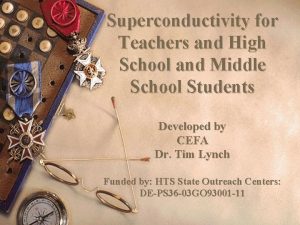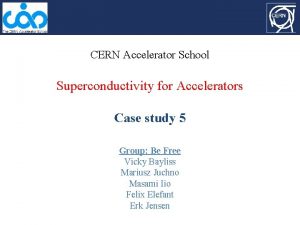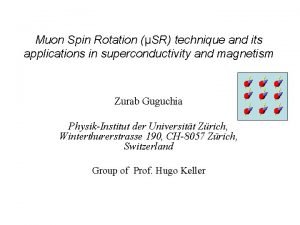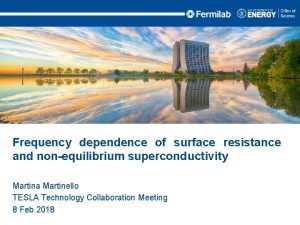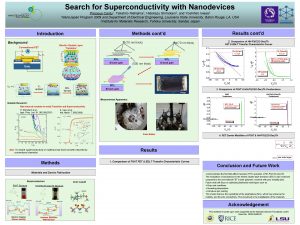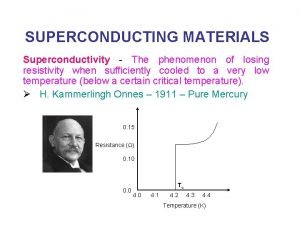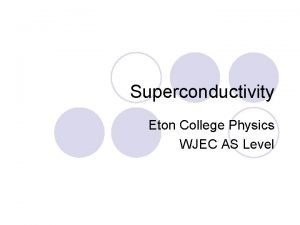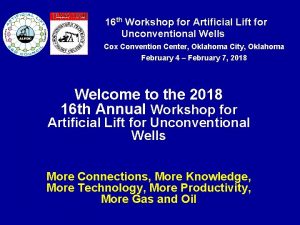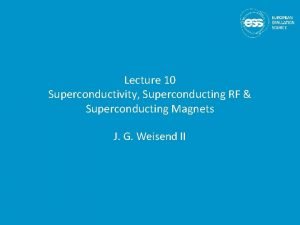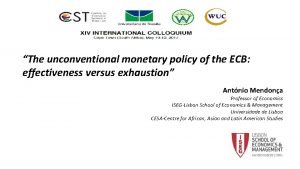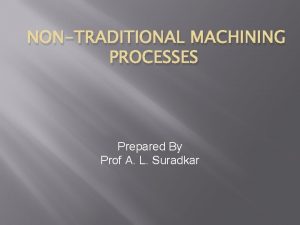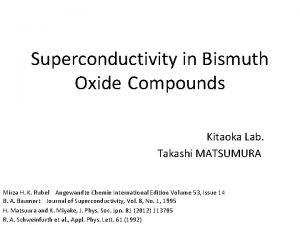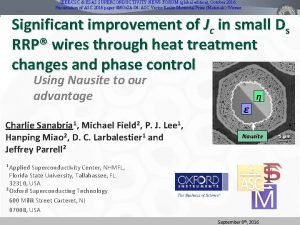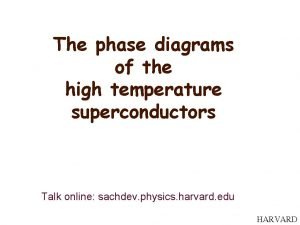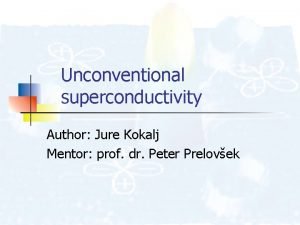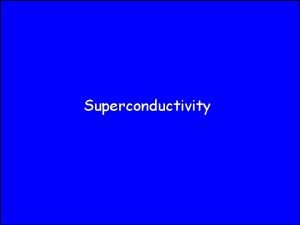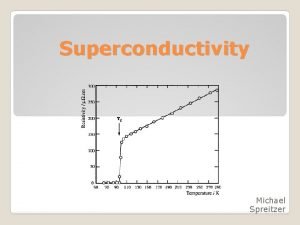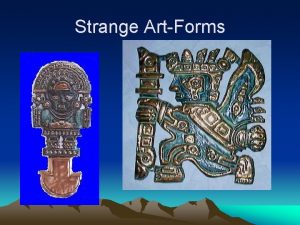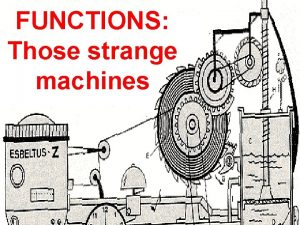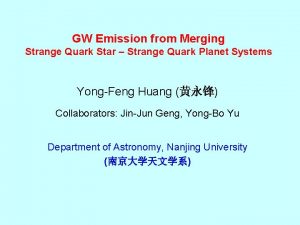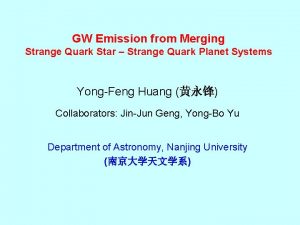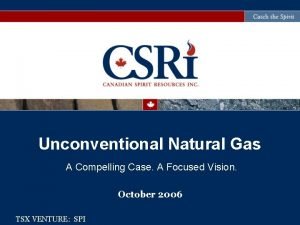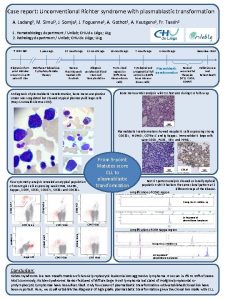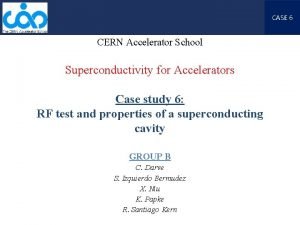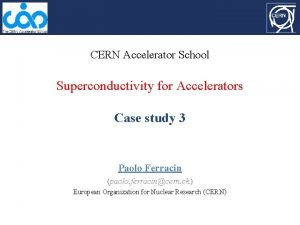Unconventional superconductivity The strange case of Ce Cu


















- Slides: 18

Unconventional superconductivity? The strange case of Ce. Cu 2 Si 2 F. Steglich+, §, # + Max Planck Institute for Chemical Physics of Solids (MPI CPf. S), Dresden, Germany § Center for Correlated Matter, Zhejiang University (CCM, ZJU), Hangzhou, China # Institute of Physics, Chinese Academy of Sciences (IOP, CAS), Beijing, China Collaboration Neutron scattering, STM/STS J. Arndt, O. Stockert, S. Wirth (MPI CPS, Dresden) Penetration depth, specific heat G. M. Pang, M. Smidman, J. L. Zhang, L. Jiao, Z. Weng. Y. Chen, W. Jiang, Y. Zhang, W. Xie, H. Lee, H. Q. Yuan (CCM, ZJU Hangzhou) Single crystals H. S. Jeevan, P. Gegenwart (U. Augsburg): Ce. Cu 2 Si 2 C. Krellner (U. Frankfurt): Yb. Rh 2 Si 2 Theory G. Zwicknagl (TU Braunschweig) J. X. Zhu (LANL) E. M. Nica, R. Yu, Q. Si (RCQM, Rice U. , Houston, TX)

Phase diagrams of unconventional superconductors Cuprates, …… Organic charge-transfer salts, Fe-based compounds, B. Keimer et al. , Nature (2015) Spin, charge, orbital, lattice excitations Heavy fermion metals separation of scales: λSO(103 -104 K), ΔCF(102 K), TK , TRKKY(10 K), Tc (1 K) ↷ spin - / charge - fluctuations Quantum critical paradigm: AF QCP in clean, stoichiom. HF metal ↷ unconv. SC! Explore Ce. Cu 2 Si 2 & Yb. Rh 2 Si 2!

Ce. Cu 2 Si 2 Homogeneity range: ~ 1% Cu/Si site exchange ΔCF ≫ k. BTK∽ JK ≃ 2 me. V Seff = 1/2 Pairing interactions ≤ IRKKY ≃ JK ↑ ← Cu deficit true stoichiometry Cu excess →

Quantum criticality in Ce. Cu 2 Si 2 Δρ ~ T 3/2, γ = γ 0 – b. T 1/2 [P. Gegenwart et al. , PRL 81, 1501 (‘ 98)] S-type crystal in low-T n-state χ‘‘T 3/2 = f (ħω/(k. BT)3/2) [J. Arndt et al. , PRL 106, 246401 (’ 11)] B - p phase diagram [E. Lengyel et al. , PRL 107, 057001 (‘ 11) A/S-type crystal 3 D-SDW QCP

(1 -band) d - wave superconductivity in Ce. Cu 2 Si 2 Cu NQR K. Fujiwara et al. , JPSJ 77, 123711 (‘ 08) cf. also K. Ishida et al. , PRL 82, 5353 (‘ 99) T = Tc : no Hebel-Slichter peak T < Tc : 1/T 1 ~ T 3 d - wave SC, nodes of Δ(k) strong coupling d – wave SC: coupling d - wave SC: 2Δ 0/k. BTc = 5 [weak 2Δ 0/k. BTc = 4. 3]

T - dependence of specific heat for Ce. Cu 2 Si 2 [S. Kittaka et al. , PRL 112, 067002 (2014)] Fully gapped as T → 0 T. Takenaka et al. , PRL 119, 077001 (2017): Tc insensitive against el-irradiation ↷ Ce. Cu 2 Si 2: Two-band s-wave superconductor without sign-changing Δ(k) [BCS SC]

T - dependence of superfluid density ϱs(T) in Ce. Cu 2 Si 2 [G. M. Pang et al. , PNAS 115, 5343 (2018)]

Harmless disorder in Ce. Cu 2 Si 2 G. M. Pang et al. , PNAS 115, 5343 (2018) Tc ≃ 0. 6 K insensitive against variations of ϱ 0 : ϱ 0(“S”) ≃ 4 ϱ 0(“A/S”) • Cu/Si interchange < 1 % (change of ϱ 0) harmless • shift from lattice sites into interstitials (el. irradiation)

Atomic substitution in Ce. Cu 2 Si 2 [H. Spille, U. Rauchschwalbe, FS, Helv. Phys. Acta 56, 165 (1983); H. Q. Yuan, F. M. Grosche, M. Deppe et al. , Science 302, 2104 (2003)] site dependence Si-site: xc: (15 – 20) at% for Ge x = 0. 1: lmfp> ξ ; 0. 25: lmfp< ξ Cu-site: xc ≃ 1 at% for Mn, Pd, Rh (ΔTK ≃ + 7 m. K) Ce-site (size-dependence): Δr. Ce-M [Å] xc[at%] Sc + 0. 28 1 Y + 0. 13 6 Th + 0. 06 20 Incompatible with s++ pairing La - 0. 03 10 [P. W. Anderson, Phys. Rev. Lett. 3, 325

Nature of the AF (A) phase in Ce. Cu 2 Si 2 [O. Stockert, G. Zwicknagl et al. , PRL 92, 136401 (2004)] Observation of AF satellite peaks in (hhl) scattering plane Long-range AF order with propagation vector QAF = (0. 215 0. 530) at T = 50 m. K TN 0. 8 K m 0 ≲ 0. 1 B

Nesting of large Fermi surface in Ce. Cu 2 Si 2 [O. Stockert, G. Zwicknagl et al. , PRL 92, 136401 (2004)] Fermi surface of heavy quasiparticles calculated with renormalized band method, m* 500 me warped columns along tetragonal axis Static susceptibility in (hhl) plane Nesting for incommensurate wave vector τ ≃ (0. 21 0. 55) ≃ QAF Fermi surface unstable with respect to formation of spin-density wave

Superconductivity in Ce. Cu 2 Si 2 near a (3 D) SDW QCP [O. Stockert et al. , Nature Phys. 7, 119 (2011)] k = QAF B = 2 T: quasielastic line, HWHM ↷ TK B = 0: spin gap below peak at 0. 2 me. V Propagating ‘paramagnon‘ mode (not a ‘spin resonance‘) at 3. 9 k. BTc [< 2Δ 1(T=0) ≃ 5 k. BTc] [J. Arndt et al. , PRL 106, 246401 (2011)] “slowing down“ ΔГ ~ Tα α = 1. 38 ∓ 0. 16 (3 D SDW) α = 1. 5

Inelastic n-scattering reveals sign change of Δ(k) [O. Stockert et al. , Nature Phys. 7, 119 (2011)] Large INS intensity in sc state at k = QAF and low ħω , i. e. , coherence factor {1 -cos[Φ(k)]} ≃ 2, where Φ(k) is the phase difference in Δ(k) between k & k + QAF, ↷ Φ(k) ≃ π ↷ sign change of Δ(k) along QAF inside dominating HF band! ↷ No s - wave superconductor s++ : doesn‘t show sign change in Δ(k)! no onsite pairing of HFs: Ueff ≃ k. BTK! s+- : nesting wavevector different from QAF can‘t explain spin resonance! ↷ “d+d band - mixing“ Cooper pairing [E. Nica et al. ‘ 16] 2 - band d - wave SC without nodes, cf. 3 He - B phase (p - wave pairing)

Band-mixing ‘d+d ‘ pairing model: explains ALL data [(E. M. Nica, R. Yu and Q. Si. , npj Quantum Materials (2017) 2: 24] Band basis: Intraband: ~ dx 2 -y 2 Interband: ~ dxy • Finite gap on whole Fermi surface; • Sign-change of intra-band pairing (within warped cylinders).

Yb. Rh 2 Si 2: Emergence of SC by nuclear AF order [Science 351, 485 (2016)] a. TN ≃ 70 m. K: 4 f - electr. AF order TB ≃ 10 m. K: increase of M(T) TA ≃ 2 m. K: new phase transition b. Tc ≃ 2 m. K: SC [χ’’(T): 1 st order!)] c. TA ≃ 2 m. K: “A - phase“ d. B < 4 m. T: TA > Tc

TB: small sc regions, Tc: large superconducting shielding T < Tc = 2 m. K: large superconducting shielding signal in zfc - MDC(T) and χAC(T) T < TB = 10 m. K: partial sc shielding – concurs with increasing fc - MDC(T) which is illustrating decreasing primary staggered magnetization, m. AF, due to competing nuclear (A-phase) short-range correlations (nuclear spin entropy!)

Summary Yb. Rh 2 Si 2 E. Schubert et al. (2016) Bc 2‘ ≃ 25 T/K from Meissner measurements (same from shielding measurements) �MDC(T), χAC(T) prove : (bulk) heavy-fermion SC at B < 4 m. T �Yb. Rh 2 Si 2: - SC near (4 f – “Mott – type“) transition (T = 0), like Ce. Rh. In 5 at p > 0 - both systems form link between (≃ 50) HFSCs and cuprates, organics, … near true Mott transition

Quantum Critical Paradigm: Unconventional SC at HF AF QCPs Ce. Pd 2 Si 2 N. D. Mathur et al. , Nature 394, 39 (1998) ● Yb. Rh 2 Si 2: HF SC, Tc = 2 m. K ● Ce. Cu 2 Si 2: fully gapped 2 - band d - wave superconductor ● Unconventional SC near AF QCPs: robust phenomenon Further reading: M. Smidman et al. , Phil. Mag. 98, 2930 (2018)
 Types of novelty lead and examples
Types of novelty lead and examples Superconductivity introduction
Superconductivity introduction Superconductivity
Superconductivity Morenzoni
Morenzoni Superconductivity
Superconductivity Superconductivity
Superconductivity Unconventional vehicles
Unconventional vehicles Superconductivity
Superconductivity An unconventional love
An unconventional love Superconductivity a level physics
Superconductivity a level physics The most likely scenario in a capital budgeting analysis
The most likely scenario in a capital budgeting analysis Unconventional artificial lift
Unconventional artificial lift Superconductivity
Superconductivity Ecb unconventional monetary policy
Ecb unconventional monetary policy Characteristics of unconventional machining process
Characteristics of unconventional machining process Caligula’s love
Caligula’s love Superconductivity
Superconductivity Superconductivity
Superconductivity Superconductivity
Superconductivity

